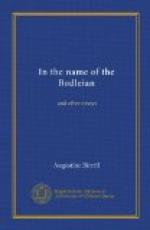Vain authors, publisher’s men, may write as they like about Shakespeare’s country, or Scott’s country, or Carlyle’s country, or Crockett’s country, but—
‘Oh, good gigantic smile of the brown old earth!’
the land laughs at the delusions of the men who hurriedly cross its surface.
’Rydal and Fairfield are there,—
In the shadow Wordsworth lies dead.
So it is, so it will be for aye,
Nature is fresh as of old,
Is lovely, a mortal is dead.’
These reflections, which by themselves would be enough to sink even an Itinerary, seemed forced upon me by the publication of A Journey to Edenborough in Scotland by Joseph Taylor, Late of the Inner Temple, Esquire. This journey was made two hundred years ago in the Long Vacation of 1705, but has just been printed from the original manuscript, under the editorship of Mr. William Cowan, by the well-known Edinburgh bookseller, Mr. Brown, of Princes Street, to whom all lovers of things Scottish already owe much.
Nobody can hope to be less known than this our latest Itinerist, for not only is he not in the Dictionary of National Biography, but it is at present impossible to say which of two Joseph Taylors he was. The House of the Winged Horse has ever had Taylors on its roll, the sign of the Middle Temple, a very fleecy sheep, being perhaps unattractive to the clan, and in 1705 it so happened that not only were there two Taylors, but two Joseph Taylors, entitled to write themselves ‘of the Inner Temple, Esquire.’ Which was the Itinerist? Mr. Cowan, going by age, thinks that the Itinerist can hardly have been the Joseph Taylor who was admitted to the Inn in 1663, as in that case he must have been at least fifty-eight when he travelled to Edinburgh. For my part, I see nothing in the Itinerary to preclude the possibility of its author having attained that age at the date of its composition. I observe in the Itinerary references which point to the Itinerist being a Kentish man, and he mentions more than once his ‘Cousin D’aeth.’ Research among the papers of the D’aeths of Knowlton Court, near Dover, might result in the discovery which of these two Taylors really was the Itinerist. As nothing else is at present known about either, the investigation could probably be made without passion or party or even religious bias. It might be best begun by Mr. Cowan telling us in whose custody he found the manuscript, and how it came there. These statements should always be made when old manuscripts are first printed.




